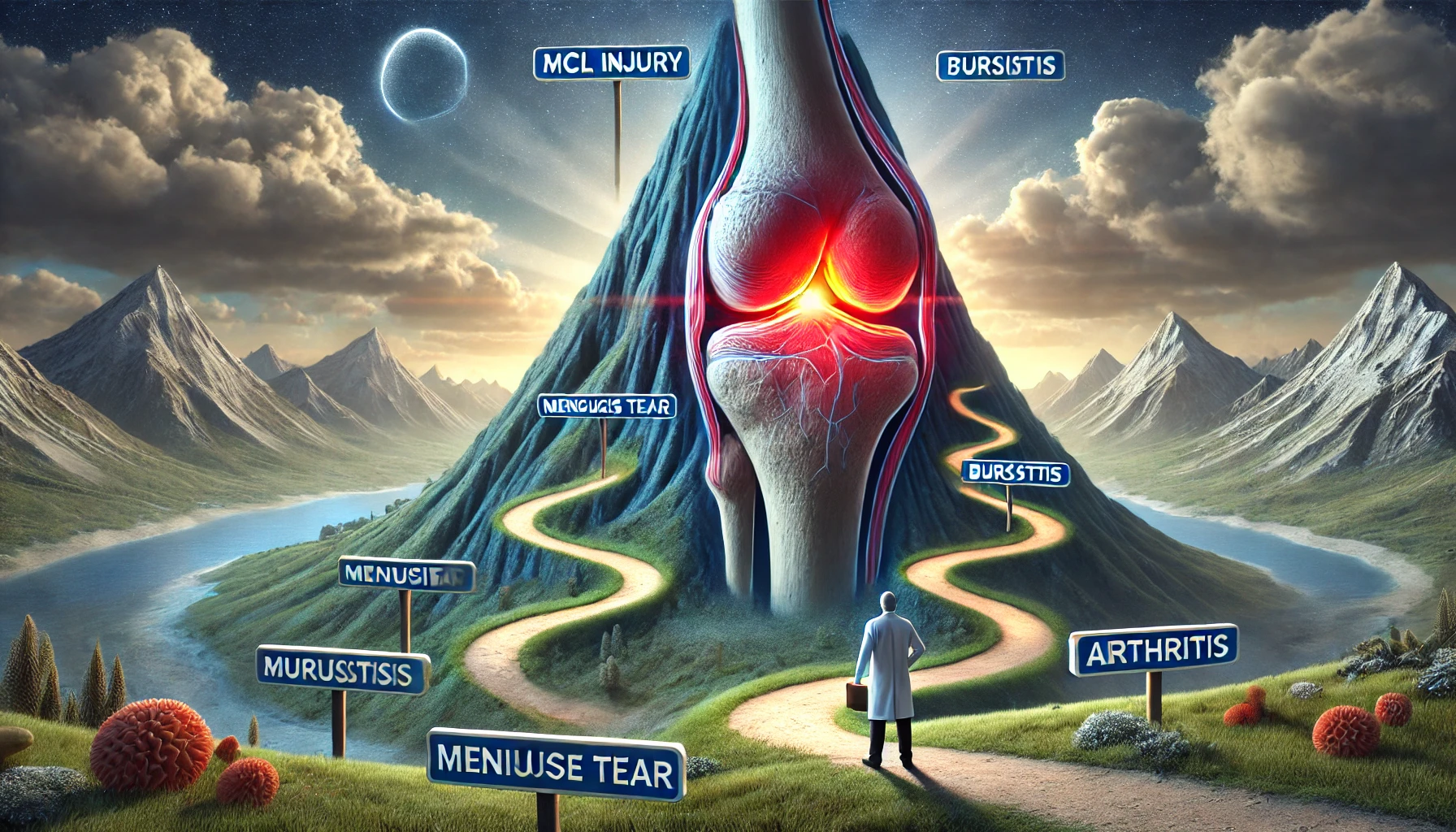As a doctor specializing in knee pain and joint health, I often see patients who complain about an ache on the inside of the knee. This type of discomfort can be frustrating, especially when it interferes with daily activities like walking, exercising, or even just standing for long periods.
In this article, I’ll share my professional insights into the possible causes of inner knee pain, how it’s diagnosed, and the best treatment options available. Whether your pain is mild or persistent, understanding the underlying issue is the first step toward relief.
Common Causes of Inner Knee Pain

When patients come to me with pain on the inside of the knee (medial knee pain), I always start by considering the most common causes:
1. Medial Collateral Ligament (MCL) Injury
One of the most frequent causes of pain on the inside of the knee is an MCL injury. This ligament runs along the inner knee and provides stability to the joint. If you’ve recently twisted your knee or experienced a direct impact, an MCL sprain or tear could be the culprit.
🩺 Symptoms:
- Swelling along the inner knee
- Pain when bending or straightening the leg
- A feeling of instability when walking
2. Medial Meniscus Tear
The meniscus is a cartilage cushion between the thigh bone (femur) and shin bone (tibia). A medial meniscus tear is common in athletes and older adults due to sudden twisting movements or gradual wear and tear.
🩺 Symptoms:
- Sharp pain when bending the knee
- Swelling and stiffness
- A locking or catching sensation in the knee
3. Pes Anserine Bursitis
The pes anserine bursa is a small fluid-filled sac inside the knee that reduces friction. When it becomes inflamed due to overuse, poor biomechanics, or arthritis, it can cause inner knee pain.
🩺 Symptoms:
- Tenderness about 2-3 inches below the knee joint
- Pain that worsens with climbing stairs or running
- Swelling in the inner knee
Also Read: Why Is My Knee Swollen – Causes, Treatment, and Expert Advice!
4. Osteoarthritis of the Knee
As a doctor, I see many middle-aged and older patients with osteoarthritis, a condition where the knee’s cartilage wears down over time. The medial compartment of the knee is often affected, leading to pain on the inside of the joint.
🩺 Symptoms:
- Gradual worsening of knee pain
- Stiffness in the morning or after inactivity
- A grinding or cracking sensation when moving the knee
5. Plica Syndrome
A plica is a small fold in the knee’s lining that can become irritated or inflamed, causing inner knee pain. This condition is often seen in runners and cyclists.
🩺 Symptoms:
- A clicking or snapping sensation in the knee
- Pain after prolonged activity
- Mild swelling
Diagnosis: How I Assess Inner Knee Pain
When a patient visits me with an ache on the inside of the knee, I follow a thorough diagnostic process:
✅ Medical History & Physical Examination
I ask about recent injuries, activity levels, and specific movements that trigger pain. Then, I check for tenderness, swelling, and range of motion.
✅ Imaging Tests
- X-rays – To check for bone damage, arthritis, or alignment issues
- MRI scans – To detect ligament tears, meniscus damage, or bursitis
- Ultrasound – To examine soft tissue inflammation
Treatment Options: How to Relieve Inner Knee Pain
Once I identify the cause of knee pain, I recommend the most effective treatment plan. Here’s what I often advise my patients:
🏠 Home Remedies for Mild to Moderate Pain
✔️ RICE Method (Rest, Ice, Compression, Elevation) – Reduces swelling and promotes healing
✔️ Over-the-Counter Pain Relievers (Ibuprofen or Acetaminophen) – Helps manage discomfort
✔️ Knee Braces or Supports – Provides stability, especially for MCL injuries
🏋️♂️ Physical Therapy & Strengthening Exercises
A well-designed rehabilitation program can speed up recovery and prevent further injuries. Some of my go-to exercises include:
✔️ Straight Leg Raises – Strengthens the quadriceps
✔️ Inner Thigh Exercises – Supports the medial knee
✔️ Hamstring Stretches – Improves flexibility and reduces tension
💉 Medical Treatments for Severe Pain

For persistent or severe pain, I may recommend:
✔️ Corticosteroid Injections – To reduce inflammation in arthritis or bursitis
✔️ Hyaluronic Acid Injections – To improve lubrication in osteoarthritis
✔️ Platelet-Rich Plasma (PRP) Therapy – To promote healing in ligament injuries
🏥 When Is Surgery Needed?
Surgery is rarely the first option, but in severe cases, I may discuss:
✔️ Arthroscopic Surgery – For repairing meniscus tears
✔️ MCL Reconstruction – For complete ligament tears
✔️ Knee Replacement – For advanced osteoarthritis
Preventing Inner Knee Pain
To keep your knees healthy and pain-free, I always recommend:
🔹 Wearing Proper Footwear – Reduces strain on the knee
🔹 Maintaining a Healthy Weight – Less pressure on the joints
🔹 Warming Up Before Exercise – Prevents injuries
🔹 Strengthening the Surrounding Muscles – Provides better knee stability
FAQ’s
1. What causes pain on the inside of the knee?
Inner knee pain is often caused by MCL injuries, meniscus tears, bursitis, osteoarthritis, or plica syndrome. Overuse and improper movement can also contribute.
2. How do I know if my inner knee pain is serious?
If your pain is severe, persistent, or accompanied by swelling, instability, or a locking sensation, you should see a doctor for an evaluation.
3. Can inner knee pain heal on its own?
Mild cases can improve with rest, ice, compression, and stretching. However, if pain persists beyond a few weeks, medical attention may be needed.
4. What exercises help relieve inner knee pain?
Strengthening the quadriceps, hamstrings, and inner thigh muscles with exercises like leg raises and hamstring stretches can provide support and reduce pain.
5. Should I wear a knee brace for medial knee pain?
A knee brace can help stabilize the knee and reduce strain, especially for ligament injuries like an MCL sprain.
6. What are the best treatments for medial knee pain?
Treatment depends on the cause but may include physical therapy, pain relievers, knee braces, steroid injections, or surgery for severe cases.
7. Can inner knee pain be a sign of arthritis?
Yes, osteoarthritis is a common cause of gradual, aching pain on the inside of the knee, especially in older adults.
8. When should I see a doctor for inner knee pain?
See a doctor if your pain doesn’t improve with rest, affects daily activities, worsens over time, or is accompanied by swelling or instability.
Final Thoughts
As a doctor, I always remind my patients that early intervention is key. If you’re experiencing an ache on the inside of your knee that doesn’t improve with rest or home treatments, it’s best to see a doctor for a proper diagnosis and treatment plan. Have you been dealing with inner knee pain? Share your experience in the comments, and let’s discuss ways to keep your knees strong and pain-free!
Related Post
- Zimatejigemo – Unlocking the Fusion of Creativity, Identity, and Innovation!
- Tinaypimatelate – The Revolutionary Concept Shaping the Future of Innovation!
- Limhuloxidpov – A Complete Guide to Understanding This Unique Concept!
- Zaxtexporoz – Exploring the Emerging Concept of Innovation and Digital Transformation!
- Lekulent – The Breakthrough Wellness Solution Taking the Health World by Storm!






